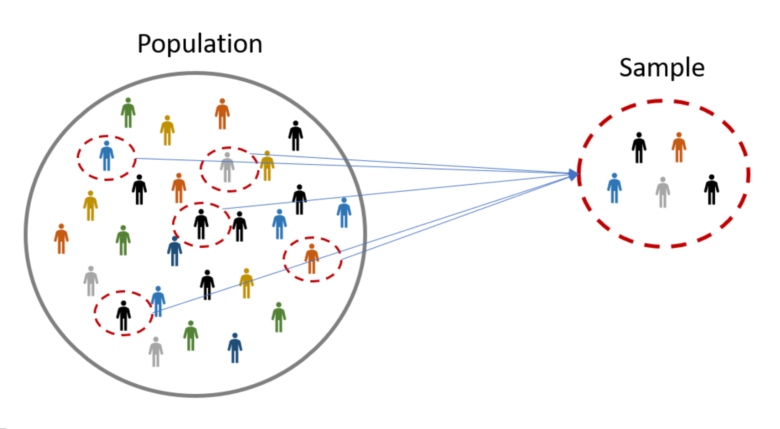To conduct a survey, the first and foremost thing is to determine the sample size. It is helpful in projecting the process parameter called “population mean”. Determination of sample size is important because very large samples can be a waste of money, time and resources of an organization.
On the other hand, too small surveys won’t allow you to obtain maximum insights and hence lose their effectiveness. It may even result in an inconclusive outcome. In this post, shall talk about the importance of sample size, and how to accurately calculate minimum sample size, as per the custom requirements of a survey.
Ovationmr.com is one of the leading companies that has built more than 200 online panel sites and communities for the best-known brands and prestigious market research firms throughout the world. They provide simple and precise sample size calculators, which is a handy tool for the surveyors for sample size estimation.
Why does an organization have to decide on the sample size?

It is an important part of any study, survey, or research, because a proper sample size will be important for conclusively arriving at a decision. Less than the bare minimum respondents will not help in getting accurate results. There can be no limits to the maximum sample size, but the bare minimum sample size is important for the success of a study. Any researcher will first need to clearly define the sample size to plan a proper study.
What are the different types of samples organized by companies?

Various types of surveys are conducted by companies. Each of these surveys varies based on their objective and sample size. So, before we learn how to determine sample size, let us learn about the different types of surveys.
- Human resources surveys:
An HR survey is a wonderful way to learn about the feelings and sentiments of employees at the workplace. Such surveys provide a more holistic view of employees and their feelings about the work environment.
- Customer satisfaction surveys:
This type of survey is conducted to obtain positive or negative feedback from customers in regards to new product launches etc.
- Market research survey:
Companies are looking for new ways to improve their products or services, in order to attract new customers and also for retaining their existing ones. Market research gives them a deep insight on what their potential or existing customers have to say about their product or service. Companies also get to know about what more needs to be done for long term branding success, and for creating happy customers.
- Education surveys:
These surveys can be useful for the schools, and also for students to do their academic projects.
- Healthcare surveys:
These surveys are conducted to identify health concerns for your patients. The result of these surveys proves to be vital in arriving at inferences in medical research.
- Casual surveys:
These surveys are sent to friends, family members, and colleagues, etc. for fun.
About Sample Size

It is basically the numbers of respondents or participants who complete the survey form, which can be either online or on paper forms. It helps in getting opinions and ideas from more people, who are connected to the survey topic in one way or the other.
Samples can be either specific or vague. Some companies use random samples wherein they choose respondents from the targeted population. Some companies might choose people based on area, age, occupation, etc.
The segmentation of subjects for the samples can be done according to various demographics or factors like age, gender, financial status, job designation, etc.
Calculation of a sample size

To compute a sample size, an organization should first understand the three important components of sample size calculation. These are:
- Population size:
It indicates the total number of people that will be considered for the study. These are the people whose behavior or viewpoint your sample will signify.
- The margin of Error:
Since the entire target population does not participate in the surveys, there is bound to be a margin for error in the derived results or conclusions. The minimum sample size is important here to reduce the possible errors, but then again it might still not be fully precise. Surveys generally give the approximate results, but they do point towards specific trends.
- Sampling Confidence Level:
It basically points towards the accuracy of results or conclusion that is derived from a survey. The probability standard is set at 95%, and anything less than that will not build the confidence on the study. If the respondents are too less, it can increase the turnaround time for the study. Sample choice and minimum size will help to achieve the confidence level.
- Response rate:
It is basically the percentage to responses from all the invited respondents. There is bound to be a difference in people who actually complete the surveys, and the total invites that were sent. Minimum sample size calculation should also take response rate into consideration, in order to get the desired outcome of the study. It also helps in avoiding delays.
Formula to Compute Sample Size of A Survey

N x E x Z-Score = Sample Size
N is Population Size
E is Margin of error. It is percentage in decimal form.
The Z-Score points to the standard deviations.
The below table will give you the z-score:
| Desired Confidence Level | Z-Score |
| 80% | 1.28 |
| 85% | 1.44 |
| 90% | 1.65 |
| 95% | 1.96 |
| 99% | 2.58 |
The confidence level matches a Z-score. It is a constant value required for the computation. The z-scores for the commonest confidence levels are as follows:
- 90% – Z Score = 1.645
- 95% – Z Score = 1.96
- 99% – Z Score = 2.576
Conclusion
We hope that this post has helped you to understand the importance of sample size. Companies and individual surveyors can expect to get highly accurate results, if they get it right. Online sample size calculators can be very handy for the success of your surveys.

